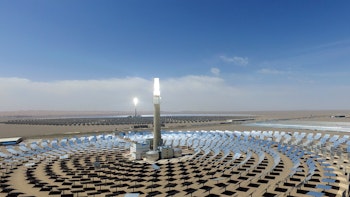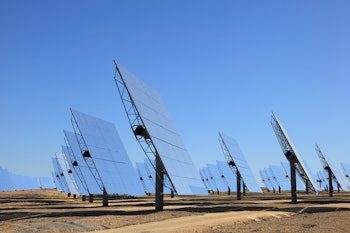
By Xavier Lara
Arid lands from China to Chile and Spain to South Africa are home to massive concentrated solar power (CSP) plants. These majestic structures trap the heat of the sun in vast vats of molten salt, which can then drive steam turbines for hours on end.
As a form of renewable energy, CSP is almost unrivalled in its ability to deliver baseload capacity. In fact, it is the perfect substitute for upcoming retirements of coal-fired generators across Australia.
A CSP plant’s massive thermal storage tanks can keep grids running overnight, something even the biggest PV plants cannot achieve with batteries.
More importantly, CSP can provide generation in early morning and late afternoon, when electricity wholesale prices are at their highest (creating what is often referred to as the duck curve), which increases the return profile compared to solar PV.
This technology was long tipped for success in Australia, a nation that has precisely the right conditions—plenty of sunshine and land—to make CSP work. Somehow, it never gained a foothold. But at Pacific Green we think the time is ripe for another try.
We are co-developing the most efficient CSP plant designed to date, leveraging ample experience gained in China plus the international experience of our team in designing, building and operating CSP plants on four continents.
This engineering marvel is Santa Cruz, a 50 MW power tower plus 5 MW PV hybrid plant currently in development in Spain.
We are keen to bring this state-of-the-art molten salt technology to Australia, scaling it to cover the needs of the nation with a family of 100 MW, 24/7 hybrid plants designed to replace fossil-fuel baseload.
Such a project would make Australia the CSP leader it has aspired to be since the late 2000s. At the time, there were various CSP technologies in play with little consensus over which might be the most effective.
Industry pioneers such as Graphite Energy, Novatec Solar and Wizard Power ended up pursuing Australian projects with technology approaches that failed to go mainstream.
In Graphite Energy’s case, the company investigated using graphite as a storage medium—a promising approach that ultimately never took off. Novatec Solar, a Spanish company, backed a CSP technology called linear Fresnel for its Liddell Power Station development in New South Wales.
Linear Fresnel proved to be more inefficient than other CSP variants, making projects less competitive.
Wizard Power tried an even more obscure CSP variant called dish Stirling, which even in the early stages of development was known to be relatively challenging from an engineering perspective. Graphite Energy, Novatec Solar and Wizard Power all eventually went out of business.
Only two Australian projects from that period survive today, both of which are less than 5 MW in capacity.
However, from a levelized cost of energy perspective Pacific Green believes CSP is a superior renewable technology to more popular assets such as photovoltaic (PV) solar power, especially when the plant exceeds 100 MW.

As CSP technology has matured, so have renewable energy markets in Australia. The amount of PV in Australia has soared over the last 10 years, from 3.8 GW in 2012 to 19 GW in 2021, according to figures from the International Renewable Energy Agency.
This is causing significant problems for the grid. South Australia, for example, was already struggling with some 1.5 GW of rooftop PV capacity in 2020.
Utilities in the state started introducing measures to curb the flood of midday solar power onto the grid, including disconnecting rooftop systems if generation levels got too high. To preserve grid stability, Australia has been building massive battery systems.
The most celebrated of these is the Hornsdale Power Reserve, a 100 MW, 129 MWh storage plant that was famously born from a bet made by Tesla boss Elon Musk and was the largest of its kind in the world when it came online in 2017.
Battery systems such as Hornsdale can protect the grid from short-term imbalances in the electricity system but cannot help with the problem of massive solar generation inflows during daytime and little renewable energy at night.
The issue is that even a massive plant such as Hornsdale can only store a limited amount of energy. The energy capacity of a battery plant is directly linked to the number of batteries it has. To discharge energy for twice as long you need twice as many batteries.
Because of this, battery systems based on lithium-ion technology—the kind used at Hornsdale—become very expensive if they are required to deliver energy over long periods of time.
Even after massive reductions in the price of lithium-ion batteries, it is uneconomical to use battery systems for storage periods longer than about four hours.
CSP does not suffer from this problem, because its storage medium—molten salt—is both a relatively inexpensive and readily available resource. Hence, you can build a CSP plant with a large solar field and massive molten salt tanks and potentially have up to gigawatt-hour levels of storage.
Projects from the latest generation of CSP plants are built to serve as gigantic solar batteries, using the daylight hours to heat molten salt.
These plants can be co-located with wind or PV to take advantage of grid connections. And in Australia there is not just a big opportunity to use CSP for grid supplies.
The technology is also ideally suited to mining and mineral extraction operations, not only because of its round-the-clock energy potential but also because its molten salt stores can serve as a source of process heat.
It is estimated that a 10 GW capacity would be able to reduce Australia’s emissions by approximately 30 million tonnes of CO2 per year...
A study last year concluded that in the Northern Territory CSP plants could cater for the needs of mining operations and the local communities. “It is estimated that a 10 GW capacity would be able to reduce Australia’s emissions by approximately 30 million tonnes of CO2 per year, which constitutes 15% of current electricity sector emissions,” say the study’s authors.
Whether for mining or grid power production, at Pacific Green we believe the time is right for Australia to embrace CSP.
And as one of the world’s leading developers of the technology, with 160 MW of projects and expertise in both the dominant power tower and parabolic trough technologies, we are confident we can deliver the kind of experience needed to kick-start a large-scale CSP industry in the nation.
We are looking for partners on this journey. To find out more, contact us now.
Publish date: 28 September, 2022